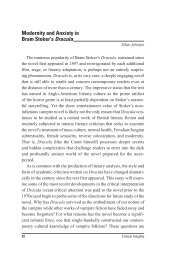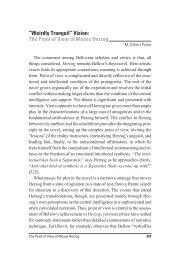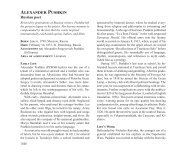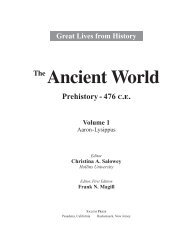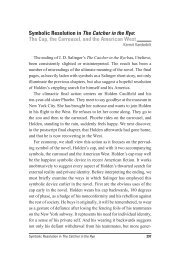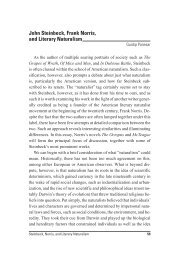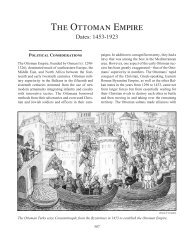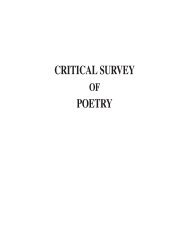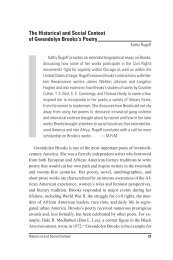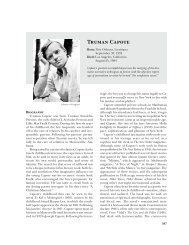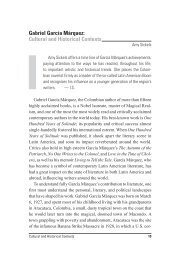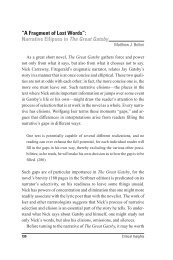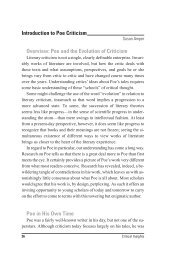Heracles's twelve labors - Salem Press
Heracles's twelve labors - Salem Press
Heracles's twelve labors - Salem Press
Create successful ePaper yourself
Turn your PDF publications into a flip-book with our unique Google optimized e-Paper software.
Heracles’s Twelve Labors │ 77<br />
a fearsome monster, Heracles must capture a hind (deer)<br />
and a boar. While Eurystheus selects mystical versions<br />
of these animals, with the hind being faster than an arrow<br />
and the boar fearsome and strong, they are both animals<br />
that are the common objects of hunts. In capturing<br />
the boar and the hind, Heracles represents the success of<br />
mortals in conquering the natural world to provide food<br />
and sustenance for themselves. This is stressed through<br />
the fact that the hind is the sacred animal of Artemis, the<br />
goddess of the hunt, while the boar likewise roams in<br />
the forests that Artemis sometimes calls home. In capturing<br />
the hind, Heracles angers Artemis, who comes to<br />
stop him accompanied by her brother, Apollo. However,<br />
Artemis hears Heracles’s story and comes to approve,<br />
giving his mortal task the blessing of an immortal. This<br />
again blends together the chthonic and the Olympian,<br />
with Heracles’s success dependent on both his earthly<br />
skills and the blessing of the gods.<br />
The fourth and fifth <strong>labors</strong> involve side stories in<br />
which there is conflict between Heracles and centaurs,<br />
moments that heighten the tension between humanity<br />
and the natural world. Centaurs, in their half-human and<br />
half-horse form, often represent the link between civilization<br />
and wilderness. This dual nature makes centaurs<br />
seem monstrous to many humans in Greek mythology,<br />
especially as they seem to suggest that humans themselves<br />
might still have feral, unsophisticated elements to<br />
their being. Heracles encounters and, through violence,<br />
conquers this nature in both <strong>labors</strong>. In the fourth, he visits<br />
a centaur friend, Pholus, who in entertaining Heracles<br />
and offering him wine demonstrates that it is possible to<br />
overcome one’s beastly nature and embrace civilization.<br />
However, the other centaurs succumb to their wild roots,<br />
attacking Heracles and meeting their death. The other<br />
centaur to whom Heracles expresses affection is Chiron,<br />
a legendary teacher and giver of wisdom in Greek<br />
mythology. When Heracles inadvertently injures Chiron<br />
with an arrow, he rushes forth to remove the weapon,<br />
which suggests that even as he conquers the animal<br />
instinct of some centaurs, he still respects the wisdom<br />
available through the natural world and humanity’s own<br />
conflicted nature. Likewise, Heracles pauses during his<br />
fifth labor in order to kill a centaur who plans to take<br />
a human woman as a wife. This follows the labor in<br />
which Heracles cleans the massive stalls of a thousand<br />
cattle and demonstrates the dominance of domestication<br />
and farming over chthonic beasts. These two examples<br />
make clear the relationship between Heracles and the<br />
natural world: humans can gain wisdom from their own<br />
animal natures, but only if they conquer those natures<br />
and take care not to indulge them too fully (as in the<br />
carnal relationship suggested by the marriage between<br />
centaur and human).<br />
The risk of unleashing the wild nature of beasts within<br />
humanity is realized in the sixth, seventh, and eighth<br />
<strong>labors</strong>. In these tasks, Heracles captures first the violent<br />
Stymphalian birds, then the legendarily fierce bull of<br />
Crete, and finally the man-eating mares of the warrior<br />
king Diomedes. In every instance, Heracles successfully<br />
captures or defeats the animals. However, other myths<br />
reveal that the birds of Stymphalian go on to pester the<br />
legendary heroes known as the Argonauts. Similarly, the<br />
story of the seventh labor mentions that Heracles eventually<br />
sets the Cretan bull free, after which it begins to<br />
harass the people of the city of Marathon. These instances<br />
show that the beasts, even once conquered, can again<br />
wreck havoc if they are unleashed within civilization. In<br />
contrast, the flesh-eating mares are likewise released but<br />
instead make their way to Mount Olympus, the home<br />
of the gods. The beasts are quickly destroyed by the<br />
animals of the mountains, suggesting that the Olympian<br />
realm (in contrast to the chthonic realm) has nothing to<br />
fear from untamed wilderness.<br />
While the first eight <strong>labors</strong> pit Heracles against the<br />
beasts of the earth, the ninth and tenth <strong>labors</strong> amplify the<br />
danger and the level of his challenge. He has already, in<br />
diverse ways, proven his superiority over the greatest of<br />
monsters. However, he has not proven similar superiority<br />
over other humans, a necessary step if he is going<br />
to elevate himself to the status of the immortals. In the<br />
ninth labor, he battles the legendary Amazons, a group<br />
of fierce women warriors, as well as the armies of a<br />
number of other leaders and warriors. While at first Heracles’s<br />
reputation is such that Hippolyte, the ruler of the<br />
Amazons, offers him the belt requested by Eurystheus<br />
freely, Hera spreads discontent among the Amazons, resulting<br />
in the battle. These battles do not represent Heracles<br />
turning against or conquering human civilization,<br />
but rather serve to demonstrate his godlike superiority in<br />
military matters. The armies he slaughters are massive,<br />
yet the hero does not tire, pressing on toward victory.<br />
Heracles also challenges the core elements of the<br />
natural world in the ninth and tenth <strong>labors</strong>. Once again,<br />
this is a heightened conflict in comparison to what<br />
came before, emphasizing that Heracles is not only<br />
demonstrating superiority over untamed nature but<br />
also reaching total deification, which will separate him<br />
from the chthonic realm. During these <strong>labors</strong>, Heracles<br />
MYTHHERO_Book.indb 77<br />
8/20/2013 2:14:02 PM



